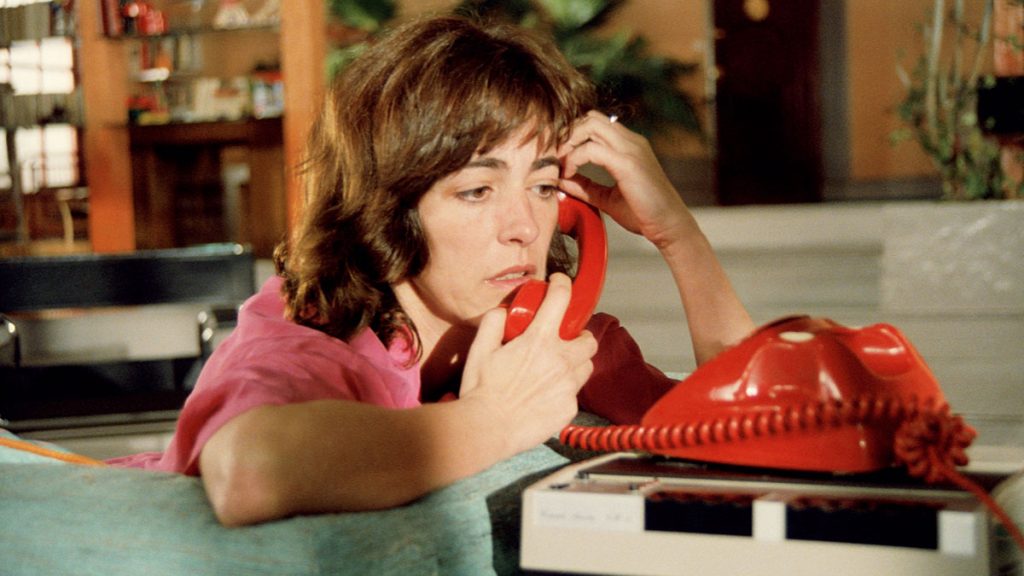Women on the Verge of a Nervous Breakdown delivers a relentlessly hilarious and delirious story of romantic entanglements, revenge, and spiked gazpacho.
In 1988, Spanish filmmaker Pedro Almodóvar finally made an international breakthrough with his romantic black comedy Women on the Verge of a Nervous Breakdown (Mujeres al borde de un ataque de nervios). It’s easy to see why this film struck a chord with audiences—Almodóvar’s signature formula of gaudy, ironic, genre-bending storytelling had achieved a symbiosis of sorts, presenting a more confident and satisfying version of his unique cinematic vision that his earlier, rougher films had not yet achieved.
Women on the Verge of a Nervous Breakdown tells the story of Pepa (Carmen Maura), a television actress who has just learned that her lover Iván (Fernando Guillén), another actor, has left her. After a series of unsuccessful attempts to contact Iván including missed messages and telephone calls, the depressed Pepa decides to kill herself by mixing sleeping pills into gazpacho. However, her plans quickly fall apart after her friend Candela (María Barranco) comes crying for help after a sexual entanglement where she unwittingly aided a group of terrorists. Meanwhile, Iván’s son Carlos (Antonio Banderas) and his demanding fiancee Marisa (Rossy de Palma) show up to tour Pepa’s apartment, where they find a burned bed and destroyed telephone, along with a distressed Pepa and Candela. To complicate matters even further, Iván’s unstable wife Lucía (Julieta Serrano), armed with a gun, is out for revenge.
Nowhere is Almodóvar’s signature style on greater display than in Women on the Verge of a Nervous Breakdown. Known for blending and reinventing genres as he sees fit, this film gracefully mixes elements of the melodrama, thriller, and screwball comedy with exceptional grace. Even as the story races through its many characters and plot twists, it never trips or gets lost in itself, keeping a consistently frantic, high-energy sense of pace to its brisk 89-minute runtime. Similarly, it manages a delicate balancing act as the screenplay oscillates between light and dark modes of humor, and its comedic tone never once feels discordant. Its most memorable running joke is Pepa and Iván’s inability to communicate with each other, a clever plot device that keeps the story running and makes for many amusing moments of anger, exasperation, and desperation that drive the story. The telephone gag is another signature Almodóvar trait—before his career as a filmmaker, he worked as a telephone repairman, and instances of miscommunication over the phone are a common occurrence in his films.

If you had to pick a single word to describe Almodóvar’s films, that word would have to be kitschy. Whether comedies or dramas, Almodóvar’s films revel in camp, and the exterior details of the worlds onscreen burst with just as much color and histrionic energy as the interior emotional states of his eclectic characters. Women on the Verge of a Nervous Breakdown is no exception, and here the gaudy sets and costumes are given just as much extroverted personality as the lively characters within the film. Minor background details like Pepa’s flowery dresses or Candela’s coffee pot earrings are easily caught by our amused eyes, and it’s impressive to see such care given to building the film’s unique visual charm. Also memorable are the scenes inside the “mambo taxi,” which is perhaps the most creatively designed car interior ever put to film with its leopard-print seats, “gracias por fumar” (“thanks for smoking”) sticker, and quirky driver (Guillermo Montesinos) who looks suspiciously like Almodóvar himself.
Women on the Verge of a Nervous Breakdown is quintessential Almodóvar, and for new viewers, this will serve as a palatable introduction to his eccentric cinematic style. Whether you’re drawn to its kitschy visuals, genre-bending storytelling, or breakneck comedic energy, it’s a pure delight to witness a film playing by its own rules and clearly having a lot of fun doing so.

